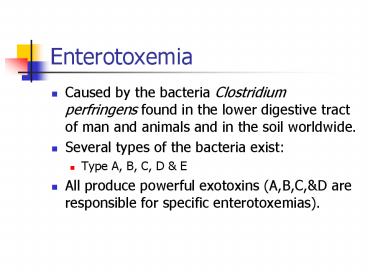Enterotoxemia PowerPoint PPT Presentation
1 / 11
Title: Enterotoxemia
1
Enterotoxemia
- Caused by the bacteria Clostridium perfringens
found in the lower digestive tract of man and
animals and in the soil worldwide. - Several types of the bacteria exist
- Type A, B, C, D E
- All produce powerful exotoxins (A,B,C,D are
responsible for specific enterotoxemias).
2
Clostridium perfringens Type A
- Cause enteritis in dogs and poultry, colitis in
horses and diarrhea in pigs and dogs.
3
Clostridum perfringens Type B
- Type B - Lamb Dysentery in lambs up to 3 weeks of
age. - Types B C - Calf enterotoxemia in well fed
calves up to 1 mo. - Type B - Foal enterotoxemia during the first week
of life. - Type C Goat enterotoxemia in adult goats.
4
Lamb Dysentery
- Clostridium perfringens Type B
- Acute disease of lambs less than 3 wks old
- Many die before signs are observed
- Lambs stop nursing, lay down and will not rise,
blood tinged fecal material, die within a few
days - Treatment is usually ineffective
- Vaccinate pregnant ewes during the last trimester
so they will produce antibodies in their clostrum
5
Hemorrhagic Enterotoxemia
- Most frequently seen in cow-calf operations(most
frequent in the mountain states and the western
part of Kansas, Nebraska, South and North Dakota) - Cl. Perfringens Type C is normally present in the
intestinal tract, only causes a problem when the
number of organisms get to high due to a slow
down or stoppage of intestinal tract movement. - Usually brought about by ingestion of an
abnormally large amount of feed allowing the
toxins to accumulate and be absorbed in the gut.
6
- The bacteria must have and abundant source of
nutrients, particularly carbohydrates to grow.
Milk is often the source in suckling calves. - The only symptom may be dead calves, however more
often acute abdominal pain, kicking at the
stomach and bloody diarrhea are seen. Death
proceeded by the calf going down and having
paddlingtype convulsions may occur in a few
hours. In less severe cases a few may survive and
recover over several days.
7
- Post mortem examination reveals reddened lesions
and a thick blood tinged fluid in the small
intestine. Hemorrhages may be seen on the thymus
and heart. - No treatment as most animals showing symptoms die.
8
- Antitoxin given at birth protects calves during
the first couple of weeks of life. - If a history of a problem with this disease
exists on a farm the cows should be vaccinated
with Clostridium perfringens Type C Toxoid.
(Usually two doses during pregnancy and yearly
thereafter)
9
Clostridium perfringens Type D
- Also called Overeating Disease or Pulpy Kidney
Disease - Seen most frequently in sheep, less frequently in
goats and rarely in cattle. - Most common in lambs less than 2 weeks old or in
feedlot lambs on a high carbohydrate diet. - Occurs in beef calves nursing high producing cows
grazing lush pasture and in feedlot cattle
(sudden death syndrome).
10
- Acutely affected calves not found dead show
mania, convulsions, blindness and death in a few
hours. (Dont confuse with rabies) - Calves dying of type D do not have the
hemorrhagic lesions in the small intestine post
mortem but due have hemorrhages on the thymus and
heart.
11
- In lambs sudden death of the best lambs is the
first symptom. Some lambs will exhibit
incoordination, circling, pushing head against
fixed objects, and convulsions before death.
Diarrhea may or may not occur. - Vaccinate ewes to prevent in lambs.
- Reduce amount of concentrate in the diet of lambs
entering the feedlot and/or vaccinate.

